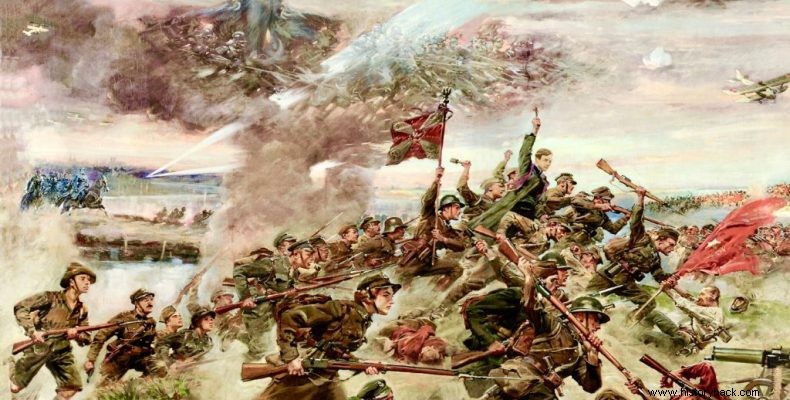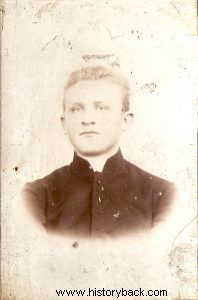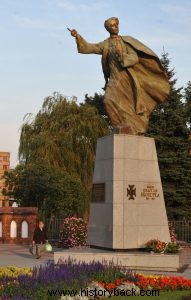
There have been thousands of heroic figures in all peoples on the long road of History. But some nations, due to "bad" geography, have no other options. Such a nation is also the Polish (as well as the Greek). Poles have been slaves of three empires since the end of the 18th century. However, the largest part of their country was occupied by the Russian Empire.
After the collapse of the tsarist regime, Poland won its freedom, but the successor state of Russia, the USSR, after the rigid Bolshevik regime was established, decided to "export" the "people's revolution". The Soviet-Polish war of 1920-21 followed with the Soviets reaching the gates of Warsaw.
The Polish leadership fought back as best they could and managed to finally defeat the Soviets at the Battle of Warsaw, also known as the "Miracle of the Vistula", a victory that was cemented on August 15, 1921, the feast day of the Assumption of the Virgin Mary (also for Roman Catholics). . The hero of this battle and victory was, in addition to the warriors, a priest who fought with the strongest weapon at his disposal, the Cross.
Military chaplain
Ignatius Ioannis Skorupka was born in 1893 in Warsaw as a Russian citizen. He was a cocky child with no particular virtues beyond his courage, but finally in 1916 he was ordained a priest. However, he was not appointed to a parish but a teacher in a high school where he taught Theology, Latin and Greek. Having come into contact with the idea of Polish independence through his brother, he developed into a leader of the Polish community in Klinze.
He returned to Poland in 1918 and was installed in the Church of the Transfiguration of the Savior in Loch. There he developed a great deal of activity teaching Polish history to children. In 1919 he was transferred to Warsaw. In 1920, however, as the Bolsheviks advanced, he enlisted in the army as a military chaplain and was assigned to the 1st Battalion of the 236th Volunteer Infantry Regiment (1/236th Infantry Regiment). Later the regiment was named the 36th Regiment of the University Legion (volunteer students of Polish universities joined its ranks).
Crisis in Osov
On the evening of August 13, the battalion reached the village of Osov. Opposite were the Soviet forces of Tukhashevsky. The village controlled a strategic crossroads where the main road to Warsaw passed. His possession was therefore of great importance for both opponents. The Poles had sent every available force of volunteers into the village as their main forces were executing a hyperbolic maneuver on the Soviet flanks.
The Poles had assembled 4 understrength regiments of the 18th Infantry Division. The remnants of the 33rd and 36th SP of the Poles had taken positions in the village. At their side, the newly formed 221st and 236th SP, also with a reduced composition, took positions with high school students.
Opposite was the 2nd Rifle Division (MT) and the 79th Rifle Brigade (TT) of the Red Army with three infantry regiments (16th, 235th and 366th) and a body of Cavalry.
The miracle...
On the day of August 14, the Soviets attacked impetuously and managed to take over the village, effectively opening the road to Warsaw. All seemed lost for the Poles, but that same night the Polish 18th Division spearheaded by the 36th SP counter-attacked. Along with the men of the 1st Battalion was of course Skorupka. The Poles charged against the Soviets but ran into the Soviet barrage and were pinned down. It was then that priest Skorupka was killed.
There are two versions of his death. The first states that he was killed while giving communion to the dying soldiers on the battlefield. The second and most well-known story states that when the 1st Battalion was pinned down, Skorupka stood up and with the cross in hand he was the first to go forward cheering on the warriors, but immediately received a fireball in the head which left him dead.
Nevertheless, the Polish counter-attack succeeded, Ossow was recaptured and the breach in the Polish defensive front was sealed. The death of the shrine became known the following day, the day of the Assumption of the Virgin Mary, and was immediately associated with the victory, creating the legend of the "Miracle of the Vistula" by the opponents of the Polish leader Józef Piłsudski, who thus attributed the victory to God and not to his plans Polish marshal.
However, the commander of the company to which the priest had joined, Lieutenant Mieceslaw Slovicowicki, wrote in his memoirs that the priest was indeed killed with the crucifix around his neck and the cross in his hand, cheering on the men who had been pinned down.
The hero priest was awarded posthumously. A monument was erected in Ossow which was destroyed by the Germans and the Soviets did not allow its re-erection after Poland's forced accession to the Eastern Bloc. Finally the monument was rebuilt in 1989.
PANTELIS D. KARYKAS


